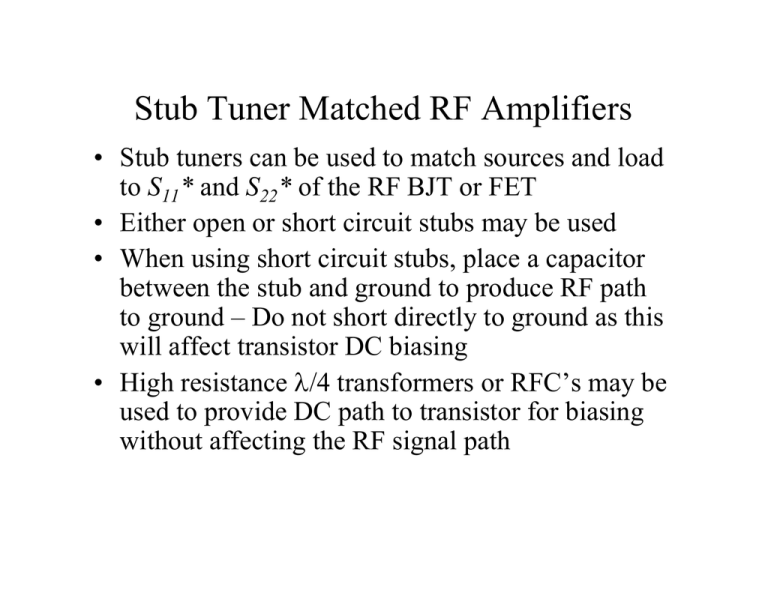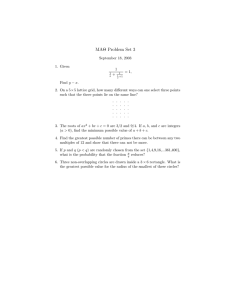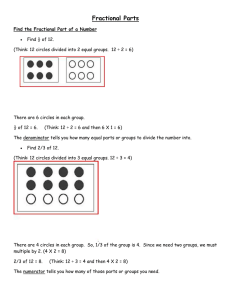Stub Tuner Matched RF Amplifiers
advertisement

Stub Tuner Matched RF Amplifiers • Stub tuners can be used to match sources and load to S11* and S22* of the RF BJT or FET • Either open or short circuit stubs may be used • When using short circuit stubs, place a capacitor between the stub and ground to produce RF path to ground – Do not short directly to ground as this will affect transistor DC biasing • High resistance λ/4 transformers or RFC’s may be used to provide DC path to transistor for biasing without affecting the RF signal path Stub Tuner Matched RF Amplifier Stub tuners of two types: Base-Side: Open Circuit Stub w/ Isolation from DC Bias Circuit Using RFC. Collector-Side: RF Short Circuit Stub via By-Pass Capacitor Power Supplies Are Cap By-Passed and RF Input and Output are Cap Coupled Series Resonant Ckt at Operating Frequency: Short Ckt at Resonance, Open Circuit at DC ω0 = 1 Lresonant Cresonant λ/4 Transformer: Transforms Short Circuit at Resonance to Open circuit at BJT Collector Thus Isolating RC from RF Signal Path The BJT “Self-Bias” Configuration Is Shown Which Produces Excellent Quiescent Point Stability Stub Tuner Matched RF Amplifier Simpler method of bias isolation at BJT collector: CBP is RF short-circuit which when transformed by the Quarter-Wave Transformer is open circuit at the Single Stub Tuner and provides DC path for the Bias Network Design Strategy: RF Amplifiers • Objective: Design a complete class A, single-stage RF amplifier operated at 1 GHz which includes biasing, matching networks, and RF/DC isolation. Design Strategy: RF Amplifier • Design DC biasing conditions • Select S-parameters for operating frequency • Build input and output matching networks for desired frequency response • Include RF/DC isolation • simulate amplifier performance on the computer Design Strategy: Approach For power considerations, matching networks are assumed lossless Power Relationships Transducer Power Gain Stability of Active Device Stability of Amplifiers • In a two-port network, oscillations are possible if the magnitude of either the input or output reflection coefficient is greater than unity, which is equivalent to presenting a negative resistance at the port. This instability is characterized by |Γin| > 1 or |Γout| > 1 which for a unilateral device implies |S11| > 1 or |S22| > 1. Stability Requirements • Thus the requirements for stability are Γin = and S11 + S12 S21Γ L 1− S22 Γ L <1 | Γ out | = S22 +l < 1 • These are defined by circles, called stability circles, that delimit |Γin | = 1 and | ΓL | = 1 on the Smith chart. Stability Regions: Stability Circles • Regions of amplifier stability can be depicted using stability circles using the following: Output stability circle: S − S ∆) S S ( r = , C = 12 out 22 21 S22 − ∆ 2 out 2 * * 11 S22 − ∆ 2 2 Input stability circle: ( S11 − S22* ∆ ) * rin = S12 S21 2 11 S −∆ 2 , Cin = S11 − ∆ 2 2 Stability Regions: Stability Circles Where: ∆ = S11S 22 − S12 S 21 Stability Regions: Output Stability Circles Stability Regions: Input Stability Circles Different Input Stability Regions Dependent on ratio between rs and |Cin| Unconditional Stability Stability circles reside completely outside |ΓS| =1 and |ΓL| =1. 2 2 2 Rollet Factor: 1− S − S + ∆ k= 11 22 2 S12 S21 >1 Constant Gain Amplifier Constant Gain Circles in the Smith Chart To obtain desired amplifier gain performance Circle Equation and Graphical Display Gain Circles • Max gain Γimax =1/(1-|Sii|2) when Γi = Sii* ; gain circle center is at dgi= Sii* and radius rgi =0 • Constant gain circles have centers on a line connecting origin to Sii* • For special case Γi = 0, gi = 1-|Sii|2 and dgi = rgi = |Sii|/(1+|Sii|2) implying Γi = 1 (0 dB) circle always passes through origin of Γi plane Trade-off Between Gain and Noise


